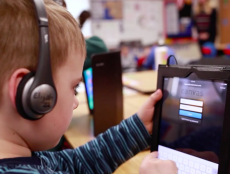
Articles
Editor’s Picks
New Study Finds eLearning Has Widened Educational Access Gap
By Cait Etherington
January 31, 2019
A new study suggests that despite all of its promises, online education may simply be expanding, not bridging, the educational access gap. “Does Online Education Live up to Its Promise?” isn’t the first study to cast doubts on online education’s purported benefits, but it is likely to fuel growing concerns, especially among politicians and policymakers.
“Does Online Education Live up to Its Promise?” is co-authored by Spiros Protopsaltis and Sandy Baum. Both authors have academic affiliations and a foot in policy circles. Protopsaltis served as a deputy assistant secretary for higher education and student financial aid at the U.S. Department of Education under Obama, and Baum is currently a fellow at the Center on Education Data and Policy at the Urban Institute. Funding for the study was provided by the Laura and John Arnold Foundation (LJAF).
Key Findings On Educational Access
In their executive summary, Protopsaltis and Baum outline several key findings on the subject educational access, including the following:
- In higher education, online education is growing faster than any other offering, especially in the for-profit education field.
- Many of online education’s stakeholders are deeply skeptical.
- Online students, especially those who start without adequate backgrounds, underperform their peers in traditional schools and classrooms.
- Online education could be less expensive but in most cases it is not.
- Regular interactions between instructors and students could improve online learning’s outcomes.
As their executive summary suggests, their study found little evidence that online education is better than traditional forms of education, especially when it comes to students at risk. In fact, as they state, a “growing and powerful body of evidence suggests that online learning is far from the hoped-for silver bullet.” Specifically, Protopsaltis and Baum conclude, “Online education has failed to reduce costs and improve outcomes for students, and it may even be exasperating existing access gaps in the educational system:
“In a range of environments, the gaps in student success across socioeconomic groups are larger in online than in classroom courses. Students without strong academic backgrounds are less likely to persist in fully online courses than in courses that involve personal contact with faculty and other students and when they do persist, they have weaker outcomes.”
Inconclusive but Troubling Research
While Protopsaltis and Baum do spend some time unpacking perceptions of online education, their study focuses on learning outcomes and where they are falling short. The authors admit, however, that it remains difficult to find comprehensive and reliable data on learning outcomes in an online context. As they explain:
“Several studies have attempted to aggregate the findings of a wide range of earlier studies on the effectiveness of online learning. These meta-analyses pre-date much of the more recent rigorous experimental work in the field. More than one summative investigation has judged that the research does not yield conclusive evidence of a systematic difference in learning outcomes between online and classroom courses, but that the variation in findings across the body of existing work is so great as to make it impossible to generalize.”
Protopsaltis and Baum further caution, “Some of the meta-studies include only rigorous peer-reviewed studies. Others explicitly include a wider range of studies, many of which are based on simple comparisons of outcomes across small groups of students.” As a result, it is also difficult to compare and contrast meta-studies.
Why the Educational Access Gap Is Likely to Widen in the Near Future
Despite the ambiguities and shortcomings of existing research on online education, Protopsaltis and Baum emphasize that there are two things that traditional and online educators and researchers consistently agree upon. First, educational outcomes are closely tied to one’s access to high-quality instructors. Second, educational outcomes are tied to program design (e.g., the amount of time students spend interacting with instructors). This is precisely why Protopsaltis and Baum warn that the educational access gap may be about to widen. Directly referencing the recently resolved audit of Western Governors University, they warn:
“In both Congress and the Department of Education, RSI [regular and substantive interactions] is now under threat. The Department of Education not only took no action on its OIG [Office of Inspector General] audit recommendations; it also announced a new regulatory effort that will reexamine RSI. The Republican proposal in the House to reauthorize the Higher Education Act would also gut both requirements by:
- Repealing the definition of and, by extent, the RSI requirement for, online education;
- Further weakening the definition of correspondence education; and,
- Adding a new CBE [competency-based education] definition that has a severely weakened, and largely unenforceable,requirement for “substantive instructional interaction, including by faculty, and regular supportby the institution.”
Protopsaltis and Baum conclude, “Weakening RSI would not only be inconsistent with the evidence that clearly demonstrates the key role of faculty-student interaction in ensuring a quality online education, but would also further erode employer, student, educator, and public confidence in and perceptions of its comparative value.”
New Study Released In Conjunction With DeVos’s Proposed Changes to Online Education
The timing of Protopsaltis and Baum’s study is likely not a coincidence. The study was published in January 2019 just as Secretary of Education Betsy DeVos’s announced that she has plans to revise what counts as a course and who can determine who counts as a qualified instructor.
As recently reported on eLearning Inside, under DeVos’s proposal, the Education Department plans to grant accreditors more agency to determine what counts as a “credit hour” in distance education and correspondence courses. In the process, Obama-era rules would be effectively overridden. Another key change concerns the right of accreditors to determine who qualifies as an instructor in a college-level course. Moving forward, accreditors will be able to make this determination without the Education Department’s approval. Some onlookers fear this will open a floodgate to the accreditation of fraudulent courses and unqualified instructors.
While Protopsaltis and Baum recognize that new technologies do hold the potential to enhance college learning opportunities, they ultimately warn, “We must proceed with extreme caution when revising the current statutory and regulatory environment governing online education to ensure that students and taxpayers are protected from poor student outcomes that come at a very high cost.” Among other recommendation, Protopsaltis and Baum emphasize that to change current regulations without putting students at risk, it will be essential for develop clear definitions and ways of measuring what constitutes substantive interaction between students and instructors. In addition, we will need to find robust ways to measure learning outcomes and not simply hours of instruction.
Photo by Andrew Neel on Unsplash.









One Comment